Effect of in Addition on Thermodynamic Properties, Wettability, Interface Microstructure, and Soldering Performance of SnBiAg–xIn/Cu Solder Joints
Abstract
:1. Introduction
2. Experimental Procedures
2.1. Preparation of Sn35Bi0.3Ag–xIn
2.2. Experiment
2.3. Characterization of Material Organization and Properties
3. Results and Discussion
3.1. Differential Heat Analysis
3.2. Wettability of Solder Joints SnBiAgIn/Cu
3.3. SnBiAg–xIn/Cu Interface Organization Analysis
3.4. Analysis of Atomic Diffusion Processes
3.5. Shear Strength and Failure Analysis of SnBiAg–xIn/Cu Soldered Joints
4. Conclusions
- The result of the differential thermal analysis shows that the addition of In elements reduces the solid–liquid phase temperature of the alloy solder. The SnBiAg–xIn (x = 0, 0.5, 1.0, 1.5) alloy solder has a small melting range of 8 °C and forms reliable joints during the soldering process.
- The wettability of the SnBiAg–xIn alloy solder on the surface of the Cu substrate first increases and then decreases with the addition of In elements. When 1.0% of the In element is added, the wettability angle of the alloy on the Cu substrate surface is the smallest at 19.0°.
- At the SnBiAg1.0In/Cu interface, where the In atoms replace some of the Sn atoms, the IMC is mainly Cu6 (Sn, In)5, whose growth rate is controlled by the diffusion of the Cu elements in the matrix and the Sn elements in the solder, but is also influenced by the In elements. The Bi and Ag3 (Sn, In) phases formed at the interface also affect the growth of the IMC.
- The SnBiAg–xIn (x = 0, 0.5, 1.0, 1.5)/Cu joint fractures from the IMC–solder side. Its shear strength first increases and then decreases with the addition of In elements. The highest shear strength of 55.1 MPa was achieved when 1.0% of In was added to the soldered joint.
Author Contributions
Funding
Institutional Review Board Statement
Informed Consent Statement
Data Availability Statement
Acknowledgments
Conflicts of Interest
References
- Zhang, L.; Han, J.G.; Guo, Y.H.; Sun, L. Properties and microstructures of SnAgCu-xEu alloys for concentrator silicon solar cells solder layer. Sol. Energy Mater Sol. Cells 2014, 130, 397–400. [Google Scholar] [CrossRef]
- Peng, F.; Liu, W.; Ma, Y.; Liang, C.; Huang, Y.; Tang, S. Microstructure of Sn-20In-2.8Ag solder and mechanical properties of joint with Cu. Solder Surf. Mt. Technol. 2019, 31, 1–5. [Google Scholar] [CrossRef]
- Gao, L.; Xue, S.; Liang, Z.; Zhong, S.; Feng, J.; Wei, D.; Yu, S.L.; Zeng, G. Effect of alloying elements on properties and microstructures of SnAgCu solders. Microelectron. Eng. 2010, 87, 2025–2034. [Google Scholar] [CrossRef]
- Tong, H.M.; Lai, Y.S.; Wong, C.P. Advanced Flip Chip Packaging. Springer: Boston, MA, USA, 2013; pp. 52–69. ISBN 978-1-4419-5767-2. [Google Scholar]
- Ren, G.; Wilding, I.J.; Collins, M. Alloying influences on low melt temperature SnZn and SnBi solder alloys for electronic interconnections. J. Alloys Compd. 2016, 665, 251–260. [Google Scholar] [CrossRef]
- Xu, K.K.; Zhang, L.; Gao, L.L.; Jiang, N.; Zhong, S.J. Review of microstructure and properties of low temperature lead-free solder in electronic packaging. Sci. Technol. Adv. Mater. 2020, 21, 689–711. [Google Scholar] [CrossRef]
- Liu, Y.; Tu, K.N. Low melting point solders based on Sn, Bi, and In elements. Mater. Today Adv. 2020, 8, 100115. [Google Scholar] [CrossRef]
- Zhu, W.; Zhang, W.; Zhou, W.; Wu, P. Improved microstructure and mechanical properties for SnBi solder alloy by addition of Cr powders. J. Alloys Compd. 2019, 789, 805–813. [Google Scholar] [CrossRef]
- Shiue, Y.Y.; Chuang, T.H. Effects of la addition on microstructure and mechanical properties of SN-58BI solders joints with osp pads. Can. Metall. Q. 2013, 52, 285–294. [Google Scholar] [CrossRef]
- Bang, J.O.; Lee, H.S.; Jung, S.B. Fabrication of Sn-58Bi-xCe Solder Paste Using Electrical Wire Explosion Method and its Mechanical Property. J. Nanosci. Nanotechnol. 2017, 17, 3033–3037. [Google Scholar] [CrossRef]
- Kanlayasiri, K.; Ariga, T. Physical properties of Sn58Bi-xNi lead-free solder and its interfacial reaction with copper substrate. Mater. Des. 2015, 86, 371–378. [Google Scholar] [CrossRef]
- Zhou, S.; Shen, Y.A.; Uresti, T.; Shunmugasamy, V.; Nishikawa, H. Effects of In and Zn Double Addition on Eutectic Sn-58Bi Alloy. In Proceedings of the 2019 IEEE 69th Electronic Components and Technology Conference (ECTC), Las Vegas, NV, USA, 28–31 May 2019. [Google Scholar]
- Wu, S.C.; Lin, S.K.; Nguyen, T.L. Effective suppression of interfacial intermetallic compound growth between Sn-58 wt.% Bi solders and Cu substrates by minor Ga addition. J. Alloys Compd. 2014, 586, 319–327. [Google Scholar]
- Li, J.F.; Mannan, S.H.; Clodm, P. Interfacial reactions between molten Sn-Bi-X solders and Cu substrates for liquid solder interconnects. Acta Mater. 2006, 54, 2907–2922. [Google Scholar] [CrossRef]
- Li, Q.; Lin, J.; Lei, Y.P. Design and properties of Sn-Bi-In low-temperature solders. In Proceedings of the International Conference on Electronic Packaging Technology (Volume 16th International Conferenceon Electronic Packaging), Changsha, China, 11–14 August 2015. [Google Scholar]
- Xue, F.; Chen, X.; Yao, Z. Effect of In on microstructure, thermodynamic characteristic and mechanical properties of Sn-Bi based lead-free solder. J. Alloys Compd. 2015, 633, 377–383. [Google Scholar]
- Shalaby, R.M. Effect of silver and indium addition on mechanical properties and indentation creep behavior of rapidly solidified Bi–Sn based lead-free solder alloys. Mater. Sci. Eng. A 2013, 560, 86–95. [Google Scholar] [CrossRef]
- Yoon, J.W.; Noh, B.I.; Kim, B.K.; Shur, C.C.; Jung, S.B. Wettability and interfacial reactions of Sn–Ag–Cu/Cu and Sn–Ag–Ni/Cu solder joints. J. Alloys Compd. 2009, 486, 142–147. [Google Scholar] [CrossRef]
- Rosa, D.M.; Spinelli, J.E.; Osório, W.R.; Garcia, A. Effects of cell size and macrosegregation on the corrosion behavior of a dilute Pb-Sb alloy. J. Power Sources 2006, 162, 696–705. [Google Scholar] [CrossRef]
- Donelan, P. Modelling microstructural and mechanical properties of ferritic ductile cast iron. Mater. Sci. Technol. 2000, 16, 261–269. [Google Scholar]
- Petch, N.J. The cleavage strength of polycrystals. J. Iron Steel Inst. 1953, 174, 25–31. [Google Scholar]
- Bonatti, R.S.; Siqueira, R.R.; Padilha, G.S.; Bortolozo, A.D.; Osorio, W.R. Distinct Alp/Sip composites affecting its densification and mechanical behavior. J. Alloys Compd. 2018, 757, 434–447. [Google Scholar] [CrossRef]
- Ma, K.; Lavernia, E.J.; Schoenung, J.M. Particulate reinforced aluminum alloy matrix composites e a review on the effect of microconstituents. Rev. Adv. Mater. Sci. 2017, 48, 91–104. [Google Scholar]
- Bouvard, D. Densification behaviour of mixtures of hard and soft powders under pressure. Powder Technol. 2000, 111, 231–239. [Google Scholar] [CrossRef]
- Meyer, Y.A.; Bonatti, R.S.; Bortolozo, A.D.; Osório, W.R. Electrochemical behavior and compressive strength of Al-Cu/xCu composites in NaCl solution. J. Solid State Electrochem. 2021, 25, 1303–1317. [Google Scholar] [CrossRef]
- Venkatraman, M.; Neumann, J.P. Binary Alloy Phase Diagrams. Mater. Eng. 1990, 86–87. [Google Scholar]
- Sun, H. Bi-Based High Temperature Lead-Free Solder Wetting and High Temperature Aging. Yan Shan University: Qinhuangdao, China, 2018. [Google Scholar]
- Kripesh, V.; Teo, M.; Tai, C.T.; Vishwanadam, G.; Mui, Y.C. Development of a lead free chip scale package for wireless applications. In Proceedings of the 51st Electronic Components and Technology Conference, Orlando, FL, USA, 29 May–1 June 2001; pp. 665–670. [Google Scholar]
- Tan, A.T.; Ai, W.T.; Yusof, F. Influence of nanoparticle addition on the formation and growth of intermetallic compounds (IMCs) in Cu/Sn–Ag–Cu/Cu solder joint during different thermal conditions. Sci. Technol. Adv. Mater. 2015, 16, 3. [Google Scholar]
- Fan, Y.; Liang, Z.; Zhi-Quan, L.; Su, Z.; Jia, M.; Li, B. Effects of CuZnAl particles on properties and microstructure of Sn-58Bi solder. Materials 2017, 10, 558–568. [Google Scholar]
- Ma, Y.Z.; Luo, H.T.; Liu, W.S.; Huang, Y.F.; Yu, Q.; Jun, Y. Effects of Bi addition on interfacial reactions and mechnical properties of In-3Ag-xBi/Cu solder joints.Journal of Materials Science. Mater. Electron. 2016, 271, 103–110. [Google Scholar] [CrossRef]
- Chang, S.Y.; Tsao, L.C.; Wu, M.W.; Chen, C.W. The morphology and kinetic evolution of intermetallic compounds at Sn-Ag-Cu solder/Cu and Sn-Ag-Cu-0.5Al2O3 composite solder/Cu interface during soldering reaction. J. Mater. Sci. Mater. Electron. 2012, 23, 100–107. [Google Scholar] [CrossRef]
- Gain, A.K.; Zhang, L. Growth mechanism of intermetallic compound and mechanical properties of nickel (ni) nanoparticle doped low melting temperature tin–bismuth (sn–bi) solder. J. Mater. Sci. Mater. Electron. 2016, 27, 781–794. [Google Scholar] [CrossRef]
- Guo, M.; Sun, F.; Yin, Z. Microstructure evolution and growth behavior of Cu/SAC105/Cu joints soldered by thermo-compression bonding. Solder. Surf. Mt. Technol. 2019, 31, 0911–0954. [Google Scholar] [CrossRef]
- Mokhtari, O.; Nishikawa, H. Effects of In and Ni Addition on Microstructure of Sn-58Bi Solder Joint. J. Electron. Mater. 2014, 43, 4158–4170. [Google Scholar] [CrossRef]


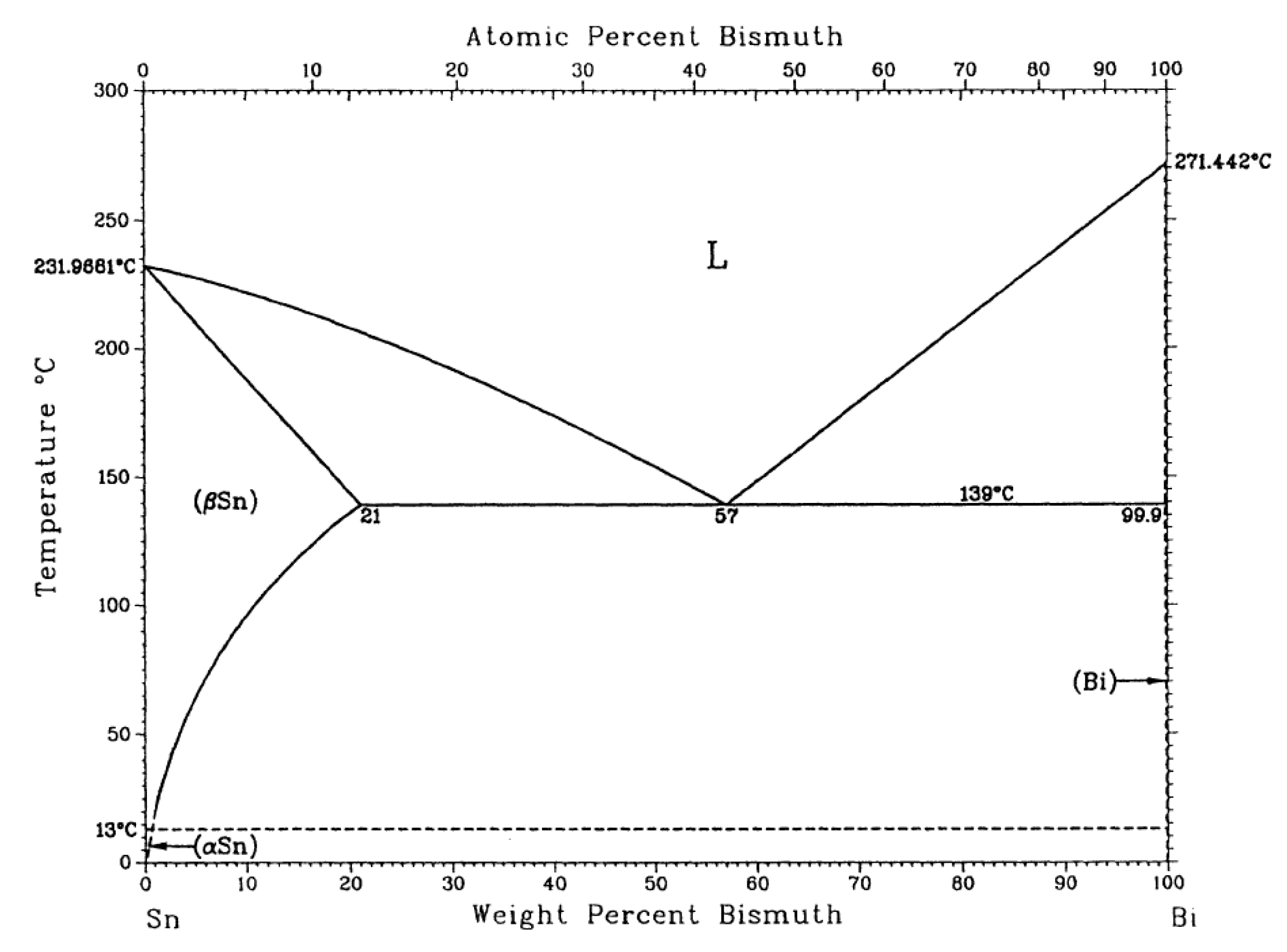
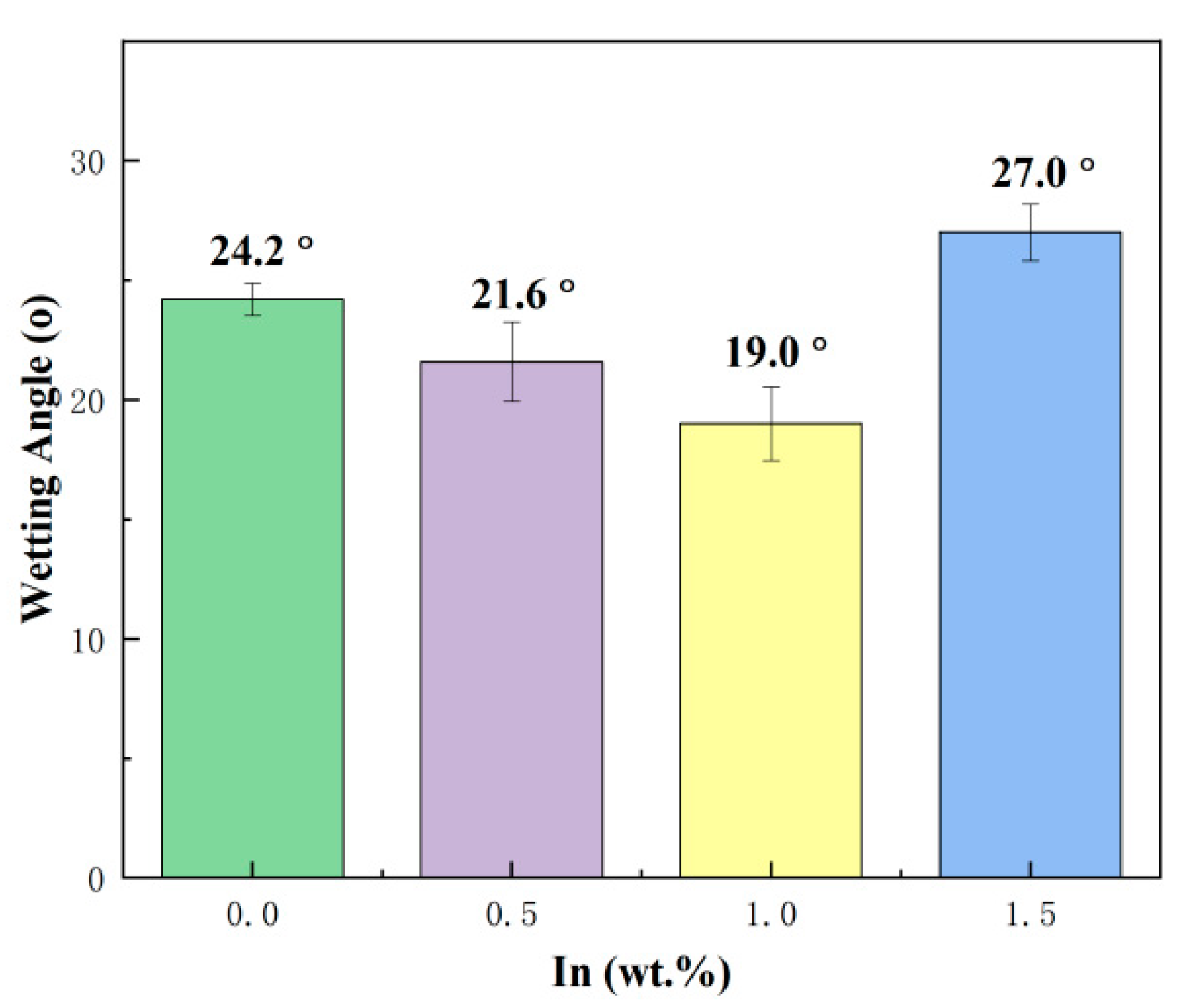
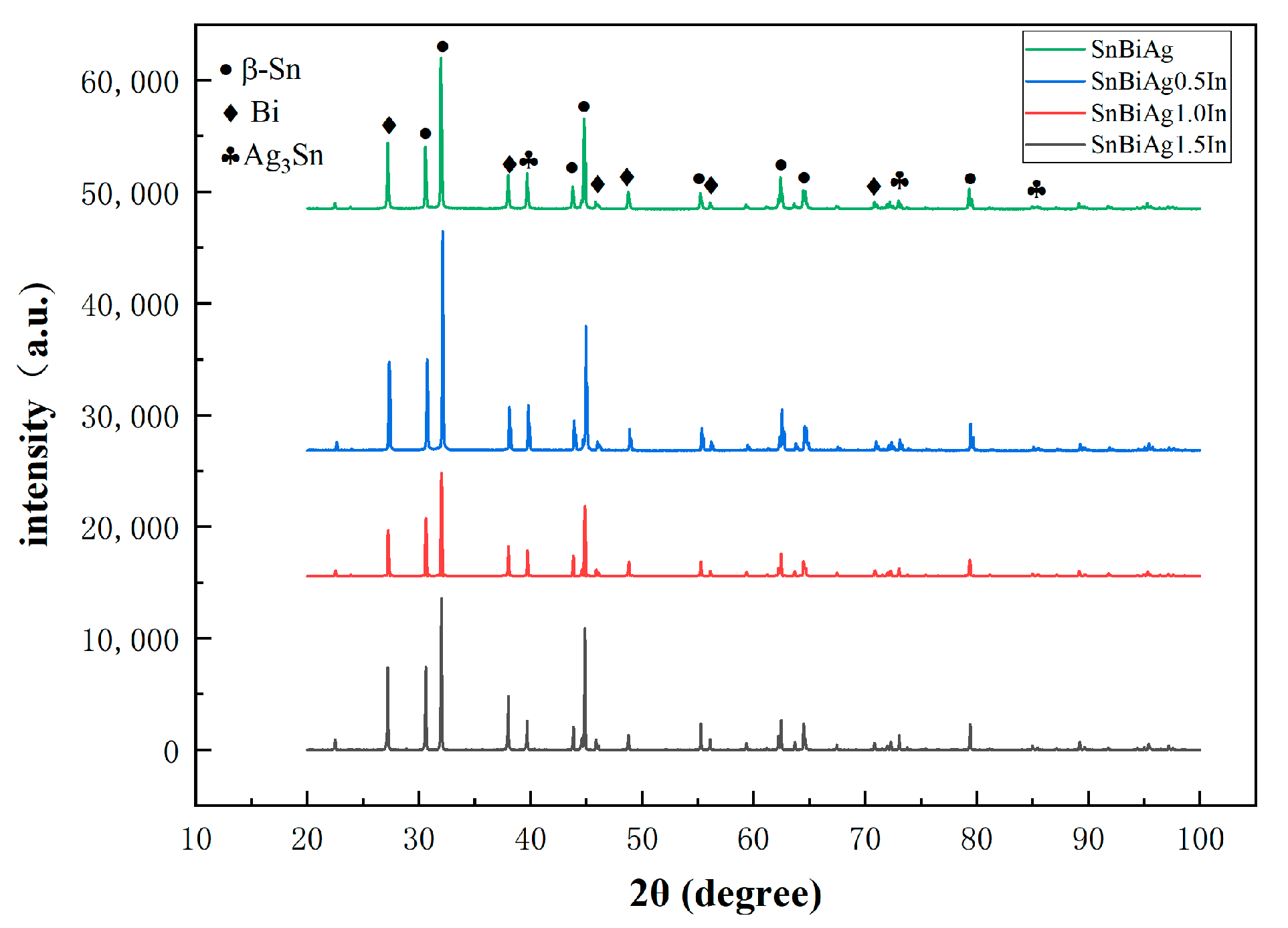

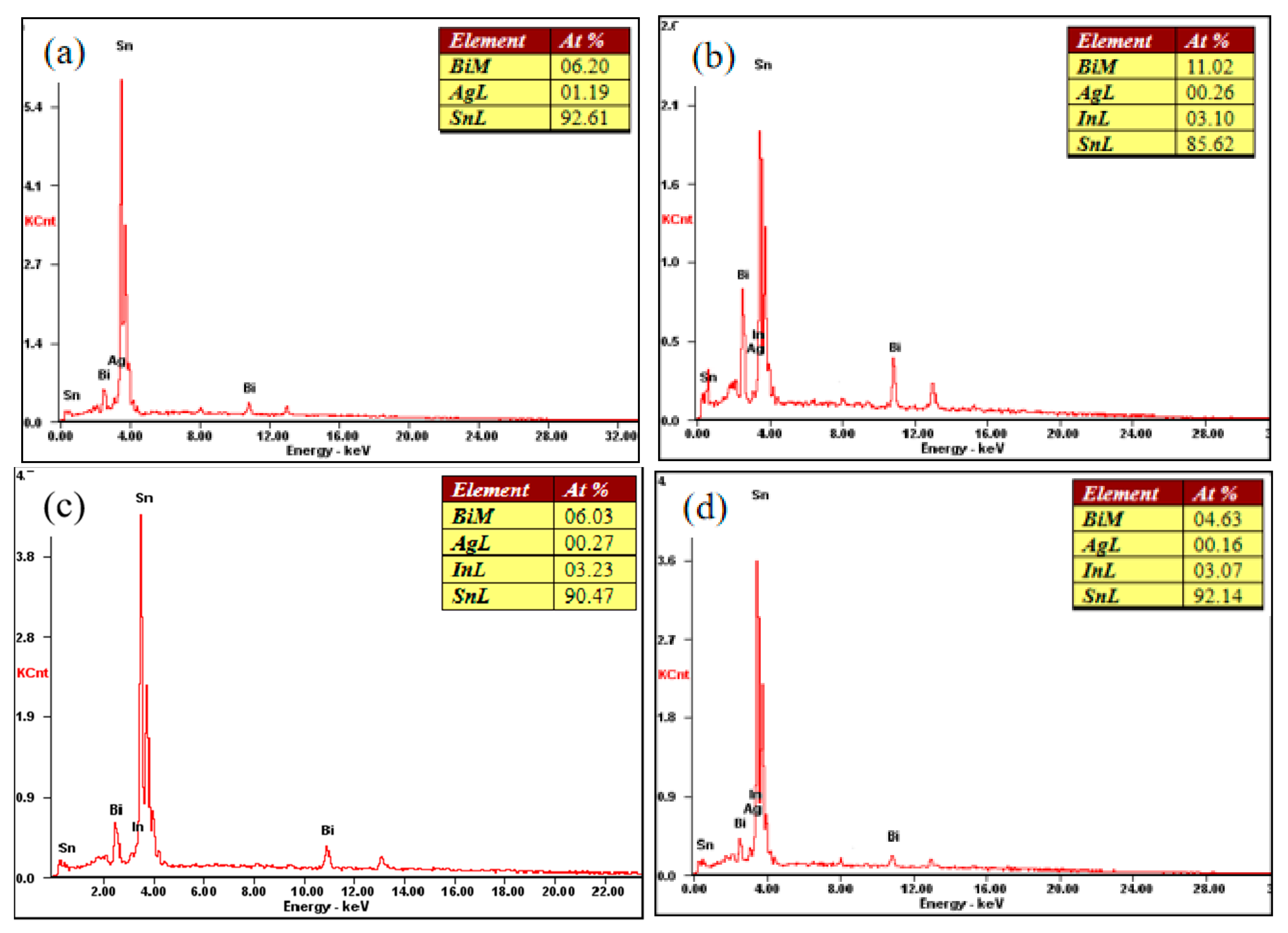
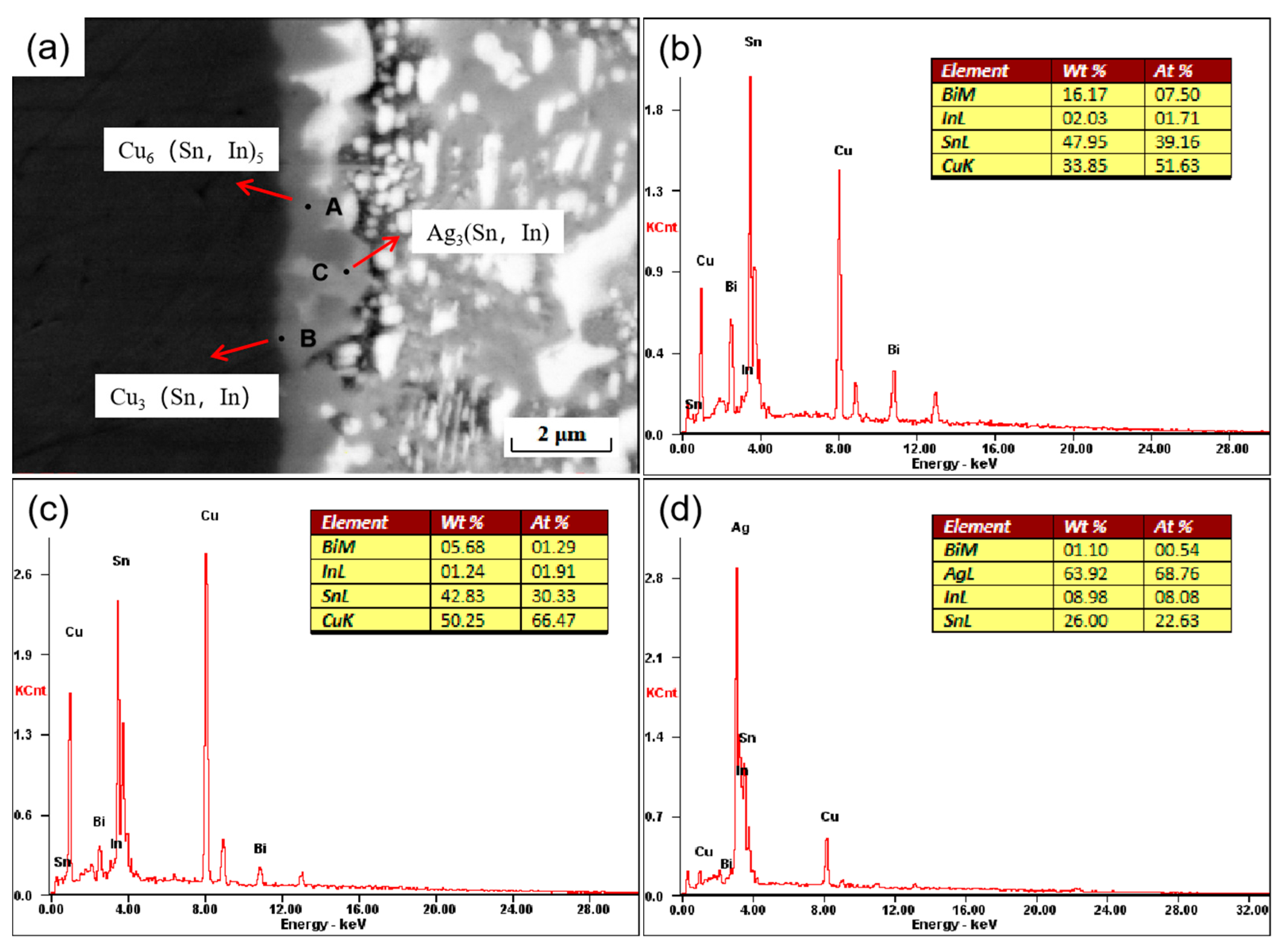

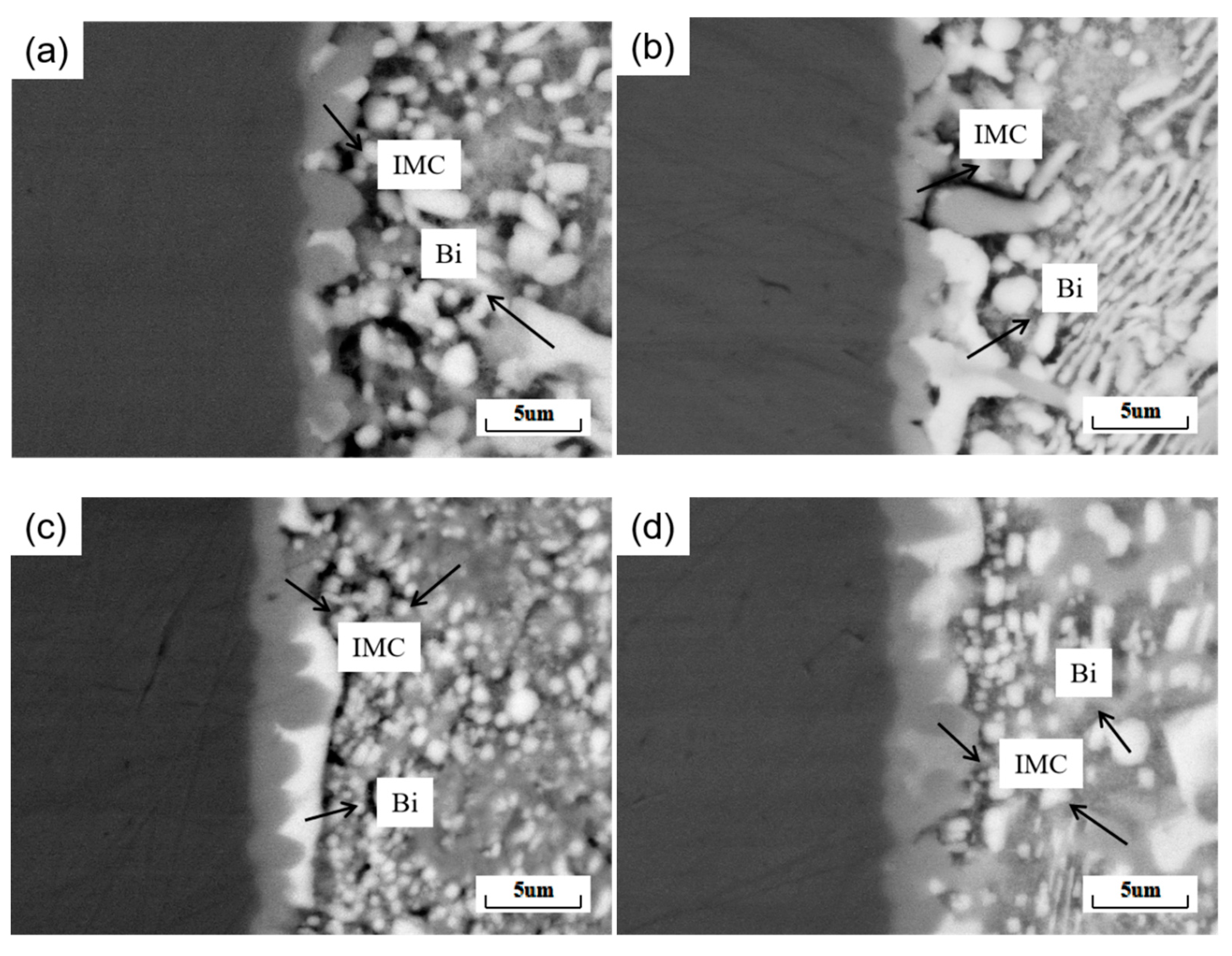

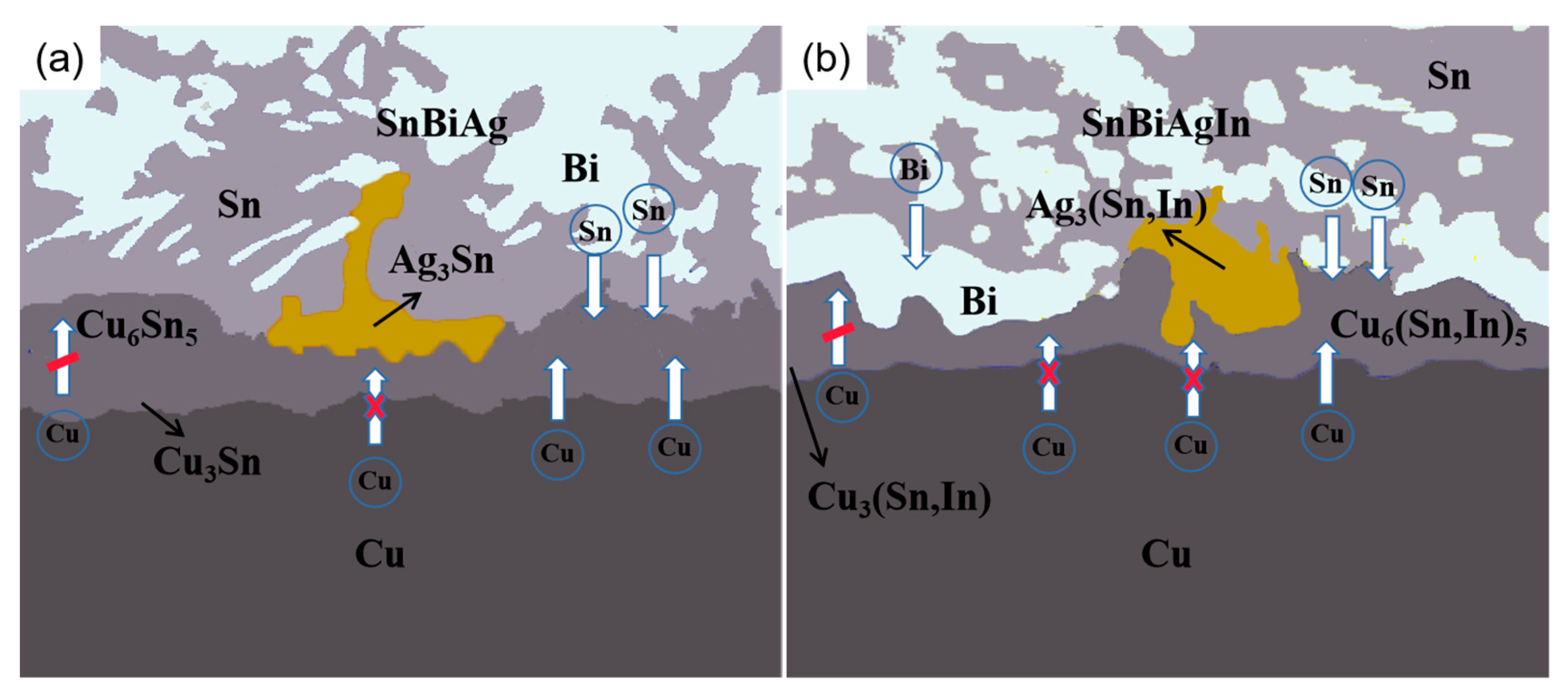


| Element | Sn | Bi | Ag | In |
|---|---|---|---|---|
| Design composition (wt.%) | Balance | 35 | 0.30 | 0, 0.5, 1.0, 1.5 |
| Actual composition (wt.%) | Balance | 34.74 | 0.31 | 0, 0.51, 1.02, 1.48 |
| In (wt.%) | 0 | 0.5 | 1.0 | 1.5 |
|---|---|---|---|---|
| Ton (°C) | 140.6 | 134.9 | 133.0 | 136.1 |
| Tp1 (°C) | 146.8 | 140.0 | 141.0 | 143.4 |
| Tp2 (°C) | 177.4 | 173.0 | 171.3 | 169.7 |
| ΔT (°C) | 6.2 | 5.1 | 8 | 7.3 |
Publisher’s Note: MDPI stays neutral with regard to jurisdictional claims in published maps and institutional affiliations. |
© 2022 by the authors. Licensee MDPI, Basel, Switzerland. This article is an open access article distributed under the terms and conditions of the Creative Commons Attribution (CC BY) license (https://creativecommons.org/licenses/by/4.0/).
Share and Cite
Shen, B.; Yang, S.; Xu, M.; Zhao, J.; Liu, G.; Xie, M.; Zhang, Q. Effect of in Addition on Thermodynamic Properties, Wettability, Interface Microstructure, and Soldering Performance of SnBiAg–xIn/Cu Solder Joints. Metals 2022, 12, 1594. https://doi.org/10.3390/met12101594
Shen B, Yang S, Xu M, Zhao J, Liu G, Xie M, Zhang Q. Effect of in Addition on Thermodynamic Properties, Wettability, Interface Microstructure, and Soldering Performance of SnBiAg–xIn/Cu Solder Joints. Metals. 2022; 12(10):1594. https://doi.org/10.3390/met12101594
Chicago/Turabian StyleShen, Bingwei, Shangrong Yang, Mingyue Xu, Jincheng Zhao, Guohua Liu, Ming Xie, and Qiao Zhang. 2022. "Effect of in Addition on Thermodynamic Properties, Wettability, Interface Microstructure, and Soldering Performance of SnBiAg–xIn/Cu Solder Joints" Metals 12, no. 10: 1594. https://doi.org/10.3390/met12101594






